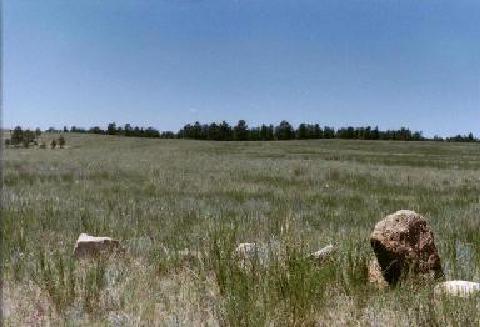Fagan's Grave
The individual who froze to death one hundred yards from Loring’s camp was a teamster named Michael Fagan. After the storm passed, a burial detail scraped away the snow alongside West Kiowa Creek, and dug a shallow grave to hold the remains of the frozen teamster. To keep the wolves away, they placed several rocks over the grave, then covered the rocks with a mound of dirt. They also erected a wooden cross with the probable inscription: “Michael Fagan – May 2, 1858.” The only eulogy given was a simple statement in the report of Colonel Loring to the Secretary of War: “a citizen teamster in the quartermaster’s employ was frozen to death….”
Just a few weeks after Fagan’s burial, the first of the gold seekers began to pass by his grave on their way to the Cherry Creek diggings. The teamster had been buried only a short distance to the east of the Cherokee Trail, just at the edge a favorite campground. After the evening meal and before writing of the day’s events in their diaries, many a gold seeker must have walked the campground and paused for a moment to read the marker above the mounded grave.
 Fagan's Grave
Fagan's Grave
Luke Tierney, 21 June 1858.
Tierney wrote these comments on Fagan’s Grave in November of 1858, when he finally found time to edit the journal of his experiences with the Russell Party. This journal was carried back east by D.C. Oakes. Oakes added a route itinerary of his own and, with the help of Stephen W. Smith, published the complete guidebook early in 1859 at Pacific City, Iowa.
“On the twenty-first we reumed our march at eleven o'clock, A.M. We passed a perpendicular rock, five hundred feet high, at the base of which was a tomb of recent origin, occupied by some unfortunate itinerant. At its head stood a wooden cross, bearing the inscription, "Charles Michael Fagan- 1858."
Source: "Luke Tierney Guidebook," Pikes Peak Gold Rush Guidebooks of 1859, ed. by LeRoy R. Hafen (Glendale, Calif.: The Arthur H. Clark Co., 1941).
William Parsons, September 1858
Parsons and the others of the Lawrence Party were traveling up the Cherokee Trail on their way to join the Russell Party on the South Platte. At Point of Rocks Parsons misread the name on the wooden cross as “O’Falley.” This mistake was immortalized in print when, in December of 1858, he issued what was to become the first of the Pikes Peak guidebooks.
“The next camping place is O"Falley's Grave, twelve miles distant, [from the Brush Corral] the whole way lying through the pinery, and marked by the various camping places of Colonel Loring - broken wagons and dead animals, all of which attest the difficulties of his march. O'Falley's grave is in an amphitheater of hills and rocks - a peaceful valley, watered by a beautiful stream. O'Falley was one of the victims of Col. Loring's march.”
Source: The New Gold Mines of Western Kansas, by William B. Parsons. (Cincinnati: George S. Blanchard, 1859).
David Kellogg, 29-30 October 1858
Gold seeker from Kansas City.
“We camped at Point of Rocks close to the grave of another of Marcy's men. A cross over the grave reads: "Michael Fagan, Died May 10th, 1857."
“October 30th, 1858. A snow storm last night; got away early;
a wolf high up on the 'Point of Rocks' overhead howled most dismally a farewell to us and a requiem to Fagan.”
Source: "Acrosws the Plains in 1858," by David Kellogg. The Trail, Vol.V, No.8 (January, 1913).
Samuel D. Raymond, 31 May 1858.
Gold seeker from Kansas City.
“Travelled to day 18 mils and encamped near 'Fagans grave.'
Water not verry good Grass tolerable. Wood abundant. Right in front of us is quite a high lege of rocks, the sides covered with pine trees. This valley is excellent for farming purposes and will at some future time be the garden of the West There is pine trees in abundence. Stone ditto. Numerous streams of water. Rich soil & an excellent climate. Nothing more is needed but the strong arm of the hardy yeomanry to subdue it and bring it to perfection. To day has been quite cool and windy - Pikes Peak is vanishing from our sight as we near Auraria.”
Source: "Samuel D. Raymond Journal," edited by Lloyd W. Gundy. Wagon Tracks, Vol.10, No.1 (November, 1995).
Calvin Perry Clark, 1 June 1859.
Gold seeker from Plano, Illinois. Clark’s unique spelling of the name Fagan is not unexpected in light of his spelling diffiulties throughout the diary.
“Fayns Grave. the above named person was frozen to death in the spring of 1858, being under the influence of the Spirrit, in undertaking to cross this devide right in the face of a snow storm.”
Source: Two Diaries (Denver: Denver Public Library, 1962).
Dr. George M. Willing, 10 June 1859.
Gold seeker from St. Louis.
“Friday, June 10. Start at 6 A.M. Ther: 48 degrees. Still raining, rained all the morning, but we are anxious to camp on Cherry Creek to night, and so we push ahead. At 10 A.M. leave the Pinery which is a fine body of timber, and enter a prairie valley, rich and well set with excellent grass. Fine farms may be made ]]ere. Pass the grave of a man named Fagan, who froze to death last May. Deer pass us in droves, but we have no time to bother with them. Pass a large flock of sheep destined for Auraria. Met a trader returning to New Mexico. Had taken flour to the mines which he disposed of to advantage. Reports the miners doing well, and making from $5 %o $25 a day. Good news if true.”
Source: "Diary of a Journey to the Pike's Peak Gold Mines in 1859," by Dr. George M. Willing. Edited by Ralph P. Bieber. The Mississippi Valley Historical Review, Vol.XIV (June 1927-March 1938).
Next Page
Home Page
©2000 Richard Gehling
E-mail me.

